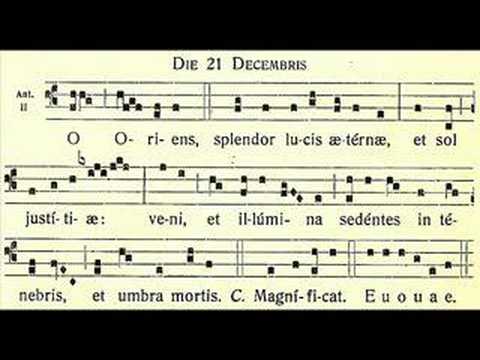
O morning star,
splendour of the light eternal and bright sun of righteousness:
come and bring light to those who dwell in darkness and walk in the shadow of death.
Amen. Come, Lord Jesus.
O Oriens,
splendor lucis aeternae,
et sol justitiae:
veni, et illumina
sedentes in tenebris,
et umbra mortis.
Numbers 24.15b-17; Luke 1:78, 79; Malachi 4:2
O come, O come, thou dayspring bright!
Pour on our souls thy healing light;
dispel the long night’s lingering gloom,
and pierce the shadows of the tomb.
Rejoice! Rejoice! Emmanuel
shall come to thee, O Israel.
O come, Thou Dayspring, come and cheer,
Our spirits by Thine advent here;
Disperse the gloomy clouds of night,
And death’s dark shadows put to flight.
O Antiphons reflection 1
O Antiphons reflection 2
Visual reflection on these beautiful prayers from New Mellleray abbey in Iowa
From at least the eighth century the antiphon before and after the Magnificat at Vespers (Evening Prayer), for the seven days leading up to Christmas Eve, has greeted Christ with a title starting with “O”. These became the basis of the popular carol “O come, O come, Emmanuel”. The initials across the seven days, when read backwards, form the Latin “Ero Cras” which means “Tomorrow I come.”
December 17: O Sapientia (O Wisdom)
December 18: O Adonai (O Lord)
December 19: O Radix Jesse (O Root of Jesse)
December 20: O Clavis David (O Key of David)
December 21: O Oriens (O Dayspring)
December 22: O Rex Gentium (O King of the nations)
December 23: O Emmanuel (O With Us is God)
The alternative English medieval practice would have
December 23: O Virgo virginum (O Virgin of virgins)
For that English medieval practice, reading the first letters in reverse Virgo Emmanuel… cutely results in Vero cras, “truly, tomorrow (I come)”!
The O Antiphons are now also used, in shorted form, in the Alleluia verses before the days’ Gospel readings.
Each day an O Antiphon could be used for prayer and reflection. These could form the basis of an Advent service with readings, music, and singing. Or of art, banners, or other ways of enhancing the worship environment symbolically. The carol “O come, O come, Emmanuel” and the Magnificat could form significant features in this.


